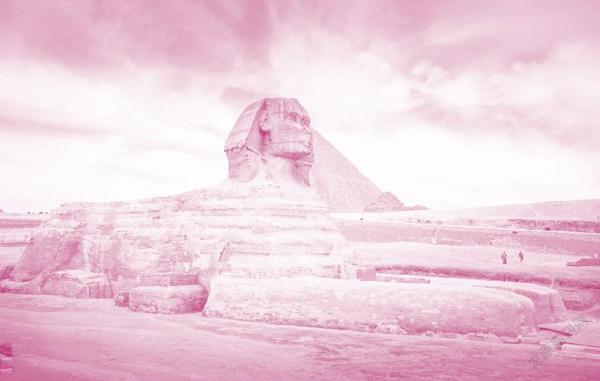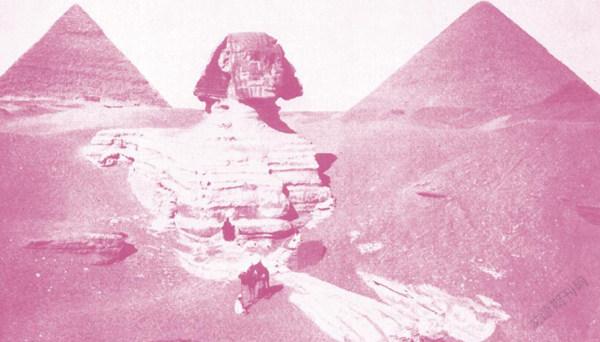巨人像和矮人像
2021-03-21



V. M. 希利尔(1875—1931),美国著名儿童教育家、科普作家, 创建了卡尔弗特教育体系。他为孩子们编写了一套趣味盎然的历史、地理、艺术读物,即《写给孩子看的世界历史》《写给孩子看的世界地理》《写给孩子看的艺术史》。本文选自《写给孩子看的艺术史》。
The Egyptian sculpture in the full round was usually giant size, as tall as a house, or the other extreme—tiny statues only an inch or so high. The statues of their kings and important people, the Egyptian sculptors usually made of giant size—colossal. They thought a statue the size of an ordinary man or woman was not nearly big enough for a king or a queen.
The biggest statue in the world is the Great Sphinx which is near the three great pyramids. It is a huge lion with a kings head. The Egyptians liked to combine men and animals in this way, but more often they put an animals head on a mans body. A cats head or a birds head on a mans body seems to us most unpleasant—a mon-strosity that makes us shudder. But a mans head on an animals body seems only a myth and doesnt shock us.
The Great Sphinx was supposed to be the God of the Morning and so faces east—always facing the rising sun and gazing at it unblinkingly as he has done each morning for thousands of years. His nose is as tall as a man. The triangular pieces at the sides of his head are not hair, they are a peculiar hood.
古埃及人雕刻了很多巨大的圓雕石像,一座石像就有房屋那么高。也雕刻了许多精致的小雕像,一座雕像只有一英寸左右高。当他们为法老或者其他身份显赫的人雕刻塑像时,都会雕刻得极其庞大、健硕。他们觉得,普通人大小的雕像不足以彰显法老或王后的重要地位。
斯芬克斯狮身人面像是世界上最大的雕像,位于三座大金字塔旁边。狮身人面像像如其名,石像将埃及法老的头部结合在狮子的身体上。将人的一部分和动物的一部分结合起来是埃及人常常使用的手法,但他们更为常用的结合方式是人身兽头像。如果一个猫脑袋或者鸟头长在人的身体上,看上去就觉得是一个会让人毛骨悚然的怪物。但是,如果让人的头部长在动物的身体上,减少了恐怖感,增加了不少神秘感。
斯芬克斯狮身人面像面朝东方——太阳升起的方向,因为在古埃及人的心目中,它就是清晨之神。每天清晨都迎接着太阳自东方升起,连眼睛都不眨一下,如此已有几千年。这座巨大的雕像仅仅一个鼻子就和一个成年人差不多高。他头后两侧的三角形物体并不是他的头发,而是一种奇特的头巾。
There are many more sphinxes in Egypt, but all much smaller than the Great Sphinx, and these smaller ones usually were arranged, with many of them in a double row, to form an avenue leading up to some temple.
Farther up the Nile, there are two colossal seated figures sitting on thrones side by side, gazing out over the plain. They are called, on account of their colossal size, the Colossi, and each is made out of a single stone. They are weather-beaten and broken, but you do not need much imagination to see in your minds eye what they once were. They of course are Egyptian kings—or rather, two statues of the same king. These two also face the sun as it rises in the east and one of them is called the Vocal Memnon—that is, the singing or sounding Memnon, though Memnon was not the kings name. His name was Amenhotep.
We know the names of few of the old sculptors who made the statues, but we do know the name of this sculptor who made these statues of Amenhotep, for he had the same name as the king. Perhaps he was a slave. When we had slavery in our own country, a slave often used to take the name of his master.
斯芬克斯狮身人面像并不是古埃及唯一的狮身人面像,不过其他的都比斯芬克斯狮身人面像要小。这些小狮身人面像通常被安放在庙宇前长长的通道两侧,整齐地立成两排,形成通向神殿的甬道。
在尼罗河上游,有两座大型雕像肩并肩地坐在王座上,一同眺望着远处的原野。这两座雕像分别由单独的一块巨石雕成,体型巨大,所以被称作巨像。经历了千百年沧桑的两座雕像,到了现在已经有些破损了。即使是这样,但相信你仍然很容易就能感受到它们昔日的壮丽。这两尊巨大的雕像雕塑的是古埃及的法老,准确地说,雕塑的是同一个法老。它们也和狮身人面像一样面朝着太阳升起的东方。这两座雕像中的一座被人称为“发声门农”,也就是会唱歌的门农的意思。“门农”并不是这位法老的名字,这位法老名叫阿蒙霍特普。
古代的雕塑家们,能够青史留名,为现代人所知的并不多。但我们却知道创作这两件雕像作品的人的名字,因为他和国王的名字一样。这个雕像作品的创作者很可能是国王的奴隶。就好像在美国,废除奴隶制之前的奴隶一般都跟随主人的姓氏一样。
For some reason that no one has ever perfectly explained, the Vocal Memnon gave forth sounds, perhaps like the tones of a great organ when the sun rose, a hymn to a new day, though the Vocal Memnon did not sing every morning or even every year. When it did sing, it was supposed to be a sign of something—an omen people called it—but an omen of what, no one knows. It is believed that about the time of Christ it was upset by an earthquake and that when it was replaced, it ceased its morning song.
It has not sung for nearly two thousand years and some people doubt that it ever did, though people even at the time of Christ used to travel long distances just to hear it sing and were disappointed if it didnt. Many who did hear it, however, have carved on the base their names and date when they did hear it. So there seems to be little doubt that it did sing once upon a time. Some scientists think the suns rays striking the cold stone in the morning wrought some change that made the sound. It is one of the mysteries of which there are so many in Egypt.
伴随着太阳升起,“发声门农”石像有时会发出声音,声音好像是大型风琴发出的一样,像是用歌声来迎接新的一天。不過石像发出声音的原因,一直不为人所知。更神奇的是,石像并不是每天或每年固定的几天唱歌,所以每当石像唱歌的时候,很多人都认为那是有特殊意义的,是某种预兆,不过唱歌到底预示了什么,又没人说得清楚。据说,“发声门农”是被耶稣时代的一场大地震震倒后才开始唱歌的。几百年后,人们又将石像重新安放回去,不过从此以后石像便不再唱歌了。
到现在已经有两千多年没人听到过石像的歌声了。现在,很多人都在怀疑石像唱歌的真实性。不过,在公元元年前后,确实有不少人专门长途跋涉去聆听石像的歌声。如果不巧石像在那几天没有唱歌,这些人就会失落而归。很多听过石像唱歌的人会把名字和日期刻在石像的基座上。由此可见,门农石像以前会唱歌应该是可以基本确定的。有些科学家指出,门农石像之所以会唱歌,其原因是当清晨的阳光洒在冰冷的石像上时,会发生特殊的反应,进而发出声音。不过,古埃及有着大量神秘的未解之谜,这只是其中的一个而已。
It is strange that one of the oldest pieces of sculpture in the world is made of wood—strange because wood of course does not usually last as long as stone. Strange, too, that it is not the statue of a king or a queen or a god, for that is what the Egyptians usually made. What do you suppose it is? A school-teacher!
This piece of sculpture is the figure of a rather small, fat, baldheaded man carrying a tall walking-stick. The statue is small, smaller than a real man, perhaps to show that he was not a king or any important person. By some people he is called the Schoolmaster of Boulac. So you can see what a school-teacher may have looked like thousands of years ago. But others say there were no regular schools or teachers then, and they call him the sheik or chief of a tribe. Still others say no, he looks like the boss of a gang of workmen, and they believe he was the boss of a gang that worked on the Great Pyramid.
So yon can take your choice, for no one knows his name or what he was or who made him. The statue is in the great museum at Cairo, the capital of Egypt. Though it was made so long ago, it looks much more natural and lifelike than later Egyptian sculpture —like a real person. It is said that even the old Egyptians thought it so natural that they chained its feet to keep it from walking off!
在這个世界上,最古老的雕塑之一是木材制成的,这是不是很奇怪。因为很显然,木头是很难像石头一样长期保存的。而且还有一点很奇怪,这座并不是常见的法老、王后或神的雕像。请你猜一猜这到底是什么人的雕像?答案是老师!
这座雕塑看上去是一个矮小又有些肥胖的光头男子,手里拄着一根拐杖。这是座还不及真人大的、较小的雕像,可能是为了表示他不是法老或者任何国家首脑吧。关于他的真实身份,众说纷纭。有的人称他为“布拉克校长”,认为从这座雕塑可以推测出古埃及时期的老师是什么样子的。不过,也有一些人持不同意见,他们指出那时候不存在任何正规的学校或正式的老师,这些人相信他应该是位部落的酋长或首领;还有一些人对上面两种意见都不赞同,认为他看上去更像是“工头”,猜测他可能负责管理那些修建埃及大金字塔的工人。
不论你相信哪一种说法都没关系,因为他到底是谁、叫什么名字,以及由谁雕刻出来的,都无人知晓。现在这座雕像被埃及首都开罗的大博物馆收藏。虽然雕像是很久以前制作的,但是制作得十分自然、逼真,就好像真人一样,甚至比后来的埃及雕像都更胜一筹。据说,正是因为雕像栩栩如生,逼真得让古埃及人不得不将他的脚绑住,害怕他跑掉呢!
Another figure made about the same time is of a man seated and holding a writing tablet on his lap. It is of stone and it was painted—not the natural color of a man but—guess what color? Red! He was a professional writer—that is, one of the few men who knew how to write and made a business of writing for those who could not write, and most people at that time could not. Think of hiring a stranger to write your letters! Such a person was called a scribe. He was a kind of secretary who took dictation. Even kings and queens could not write and had to have scribes to write for them. This figure is now in the Louvre in Paris, to which place, of course, it was carried from Egypt.
Often Egyptian sculptors went to the other extreme in making tiny statuettes, some only a few inches high, of their kings and queens, their gods and goddesses and sacred animals. Most of these miniature statues were cut out of the hardest kinds of stone—stone that would turn the edge of our modern tools. We suspect that they must have been cut with flint tools instead of steel tools—as, nowadays, a diamond, the very hardest of all stones, has to be cut with another diamond or shaped by being rubbed with diamond dust.
The beetle was sacred in Egypt and called a scarab, and numberless scarabs made of clay and stone were made to be suspended from the neck, where they acted as a charm for the wearer. So popular are these charms that they are manufactured today in great quantities and sold to travelers as real antiques.
还有一座与“布拉克校长”差不多同时完成的雕像,刻着一个坐着的人,膝盖上有一个写字板。这座雕像是石刻的,颜色完全不同于真人,你猜用了什么颜色?答案是红色!这座雕像刻画的是一名书吏,当时会写字的人很少,很多人都不会写字,需要请陌生人来帮他们写信,书吏就专门靠为别人写字为生。其实书吏也很像现在的秘书,负责记录长官的指示。在那时候,甚至连法老和王后也不会写字,不得不让书吏代笔。这座书吏的雕像现在被法国巴黎的罗浮宫收藏。当然,是从埃及搬运到巴黎的。
古埃及雕塑家雕刻的雕像大的十分庞大,小的却又极其小。有的法老、王后、神和圣物的雕像高度只有几英寸。这些极其微小的雕像绝大部分使用了十分坚硬的石块,即使用现代锋利的钢质刀具也无法切割它们。我们猜测,用来雕刻这些雕像可能是燧石制成的工具,而不是钢质工具。就好比现在,切割所有石头中最坚硬的钻石,也必须使用钻石刀具,打磨它只能使用钻石粉尘。
古埃及人认为甲壳虫是十分神圣的,因此称为圣甲虫。他们认为将石头和黏土做的圣甲虫戴在脖子上,可以作为幸运符。在埃及非常流行这种幸运符,所以现在的埃及人还在大量制作圣甲虫,把它们作为古董旅游纪念品卖给游客。
Word Study
sculpture /'sk?lpt??(r)/ n. 雕像;雕塑品;雕刻品
colossal /k?'l?sl/ adj. 巨大的;庞大的
The singer earns a colossal amount of money.
shudder /'??d?(r)/ v. & n. 发抖,打颤,战栗
Alone in the car, she shuddered with fear.
unblinkingly /?n'bl??k??li/ adv. 不眨眼的;目不转睛地
She looked at him unblinkingly.
throne /θr?un/ n. 宝座;御座;王位;帝位
weather-beaten /'we??'bi?tn/ adj. (因风吹日晒)受损的;饱经风霜的
Word Study
hymn /h?m/ n. 赞美诗,圣歌
cease /si?s/ v. 停止,终止,结束
The company ceased trading in June.
wrought /r??t/ v. 使发生了,造成了(尤指变化)
This century wrought major changes in our society.
baldheaded /'b??ldhed?d/ adj. 秃头的
sheik /?i?k/ n.(阿拉伯的)家长;酋长
gang /ɡ??/ n. 一帮,一群,一伙
A four-man gang carried out the robbery.
scribe /skra?b/ n. 抄写员,抄书吏
statuette /'st?t?u'et/ n. 小雕像,小塑像,小铸像
edge /ed?/ n. 邊;边缘;边沿 v. 缓慢地移动;给……加边
Dont put that glass so near the edge of the table.
beetle /'bi?tl/ n. 甲虫 v. 快速移动
